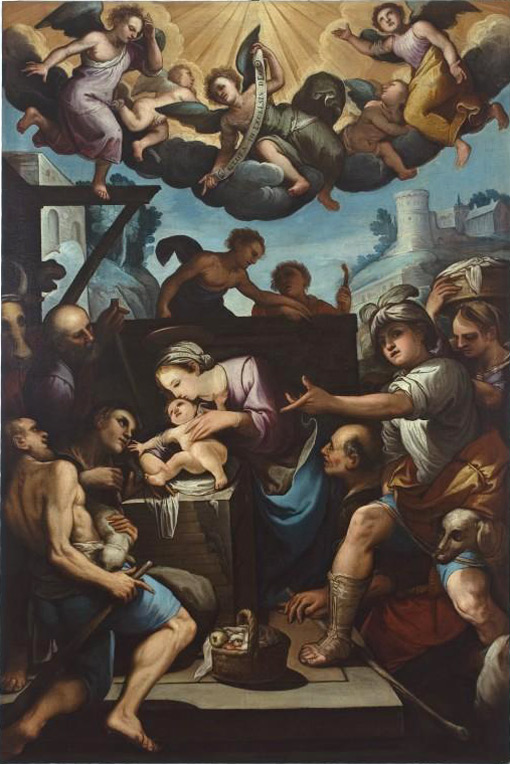Ferraù Fenzoni
(Faenza 1562 – 1645)
Adorazione dei pastori
The Adoration of the Shepards
1620-1630 ca.
cm. 235×157 | olio su tela | oil on canvas
provenienza: | provenance:
chiesa dei Cappuccini di Faenza >> chiesa dei Cappuccini di Bagnacavallo
L’opera era originariamente collocata nella chiesa dei Frati Cappuccini di Faenza per poi passare, in seguito ad un’operazione di razionalizzazione dei beni dell’Ordine avvenuta verso metà Ottocento, a quella dei Cappuccini di Bagnacavallo.
La pala è un pregevole lavoro di Ferraù Fenzoni, che replica il medesimo soggetto rappresentato in un dipinto realizzato dal faentino per la chiesa di San Domenico di Cesena (1620 ca.). Appartiene dunque alla fase della piena maturità dell’artista, successiva cioè al suo soggiorno a Roma e in Umbria dove ebbe modo di entrare in contatto con la pittura tardo-manierista dell’anconetano Andrea Lilio e della scuola romana degli Zuccari e del Cavalier d’Arpino. Rientrato a Faenza nel 1599 egli iniziò una produzione intensa e anche piuttosto ripetitiva per numerose chiese locali.
Il tema dell’Adorazione dei pastori è qui interpretato dall’artista in modo molto vivace e cromaticamente brillante. Si percepisce un’atmosfera fantastica, enfatizzata dall’uso di ombre profonde e irreali. La scena è inoltre popolata da figure di grande originalità, come il pastore in primo piano sulla sinistra, il giovane col turbante bianco o la donna che porta una cesta di offerte dietro di lui.
Per qualche ragione a noi ignota il dipinto manca della finitura pittorica nelle figure principali della Madonna e del bambino, il che conferisce loro un aspetto violentemente scarnificato.
The artwork was originally held in the church of the Capuchin friars in Faenza; during the middle of the 19th century the religious order’s belongings were restructured and the artwork was moved to the Capuchins in Bagnacavallo.
This valuable altarpiece was made by Ferraù Fenzoni; its subject matter is the same of a painting created by the artist for the church of San Domenico in Cesena (1620 ca.). The artwork was made in the most mature period of the artist’s career, after he had been in Rome and in Umbria where he got to know the late Mannerist work of Andrea Lilio, from Ancona, and of the Roman school of Zuccari and Cavalier d’Arpino. He came back to Faenza in 1599 and produced several artworks, often slightly repetitive, for local churches. The theme of the Adoration of the Shepherds is interpreted in a lively manner and with bright colours. The fanciful atmosphere is enhanced by the use of deep and unreal shadows. The characters are also quite original, such as the shepherd in the foreground on the left, or the young man wearing a white turban and the woman carrying a basket of offerings just behind him.
It is not known why the Madonna and the child, the main characters of the painting, are unfinished; for this reason it looks as if their flesh has been stripped off.




